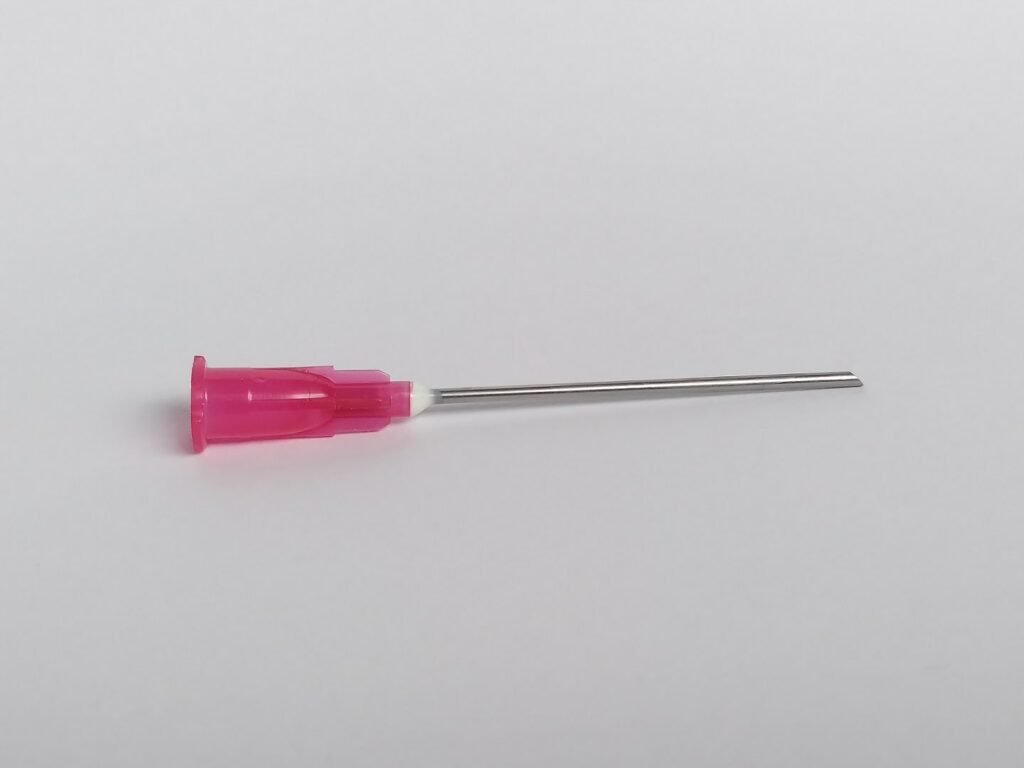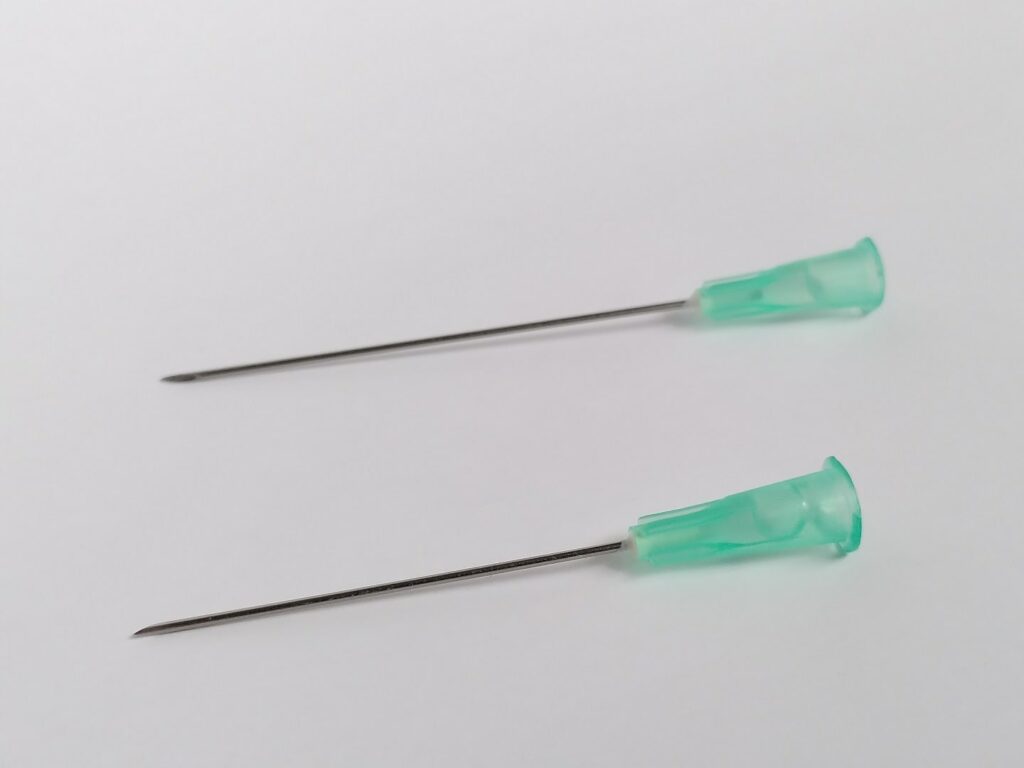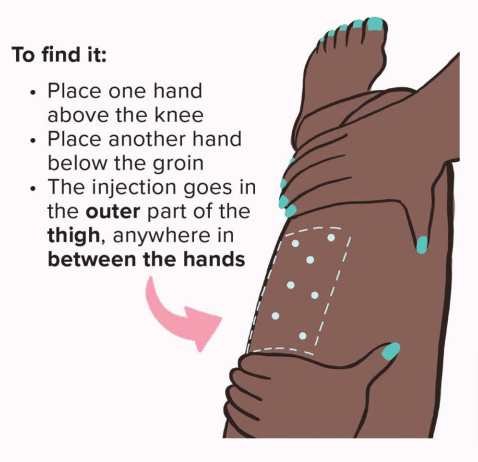One of the most popular methods of taking medication is through injections, administered intramuscularly or subcutaneously. In this guide, you will find instructions on how to properly perform them.
What will be needed?
- 2 needles (the first with a diameter of 1.2 mm, the second with a diameter of 0.8 mm for intramuscular injections, or 0.5 mm for subcutaneous injections);
- a syringe with a capacity of typically 2 ml;
- sterile gauze pads;
- a liquid for disinfecting the skin or pre-injection wipes;
- medication;
- optionally, disposable gloves.
Needles
Needles differ primarily in length and diameter, but not only that. You will need two types of needles to administer the injection.
Never use the same needle to administer medication that you used to draw it from the vial or ampule. When drawing the medication, the needle can become blunt by touching the bottom of the ampule, or glass particles may remain in the needle. Needles for drawing up medication are too thick for intramuscular injections, and may not be sharp enough at the tip. Also, do not use a thinner needle to administer the injection – hormones are often dissolved in thick oil and using a thin needle can make it difficult to draw them up, taking a long time and resulting in difficulties in obtaining the full amount of medication from the ampule.
a) needle for drawing up medication
- Make sure to use a needle with a filter. This is particularly important when drawing medication from a glass ampule as it prevents accidental ingestion of microscopic glass particles.
- For an ampule with a rubber stopper, make sure to position the needle opening on the side to avoid leaving holes in the rubber.
- A needle with a diameter of 1.2 mm (pink/purple) or 1.1 mm (cream) is used for drawing up medication.

b) needle for intramuscular injection
- For the injection itself, we usually use a needle with a diameter of 0.8 mm (green), but a needle with a diameter of 0.7 mm (black) or 0.9 mm (dark yellow) is also acceptable.
- The length of the needle is chosen based on the injection site to reach the muscle, with a needle with a diameter of 0.8 mm being the most commonly chosen.

c) needle for subcutaneous injection
- A needle with a diameter of 0.6 mm (blue) will work best for subcutaneous injections. Narrower needles of 0.42 mm (grey) can also be used, but their selection will be associated with much greater resistance of the drug during injection – due to its oily consistency, it will not easily pass through such narrow needles.
Syringe
- The most important thing to pay attention to is the capacity of the syringe, which we choose depending on the amount of our medication.
- You need a syringe that is slightly larger than the amount of medication you are drawing up, but not too large.
- For example, if we are to have an injection with 1 ml of medication, we choose a 2 ml syringe, if 4 ml of medication then a 5 ml syringe, and so on.
- The maximum single dose that can be given in one intramuscular injection is 5 ml. For subcutaneous injection, this limit is lower and amounts to 2 ml.

3. Gauze and disinfectant solution/pre-injection wipes – together they are used to disinfect the skin before injection. You can buy gauze and disinfectant solution separately, or gauze already soaked in alcohol.
Intramuscular injections
Intramuscular injections should be administered by a properly trained person. Many people choose to self-administer or have a partner assist them, often at their own risk. Below you will find the most important information needed to know what you need and what mistakes to avoid. However, this text does not constitute professional training – the safest option is to take your injection to a clinic to ensure that it is performed correctly.
Self-administered injection
If you decide to administer the injection yourself, familiarize yourself with the rest of the post to prepare properly and ensure that you are administering it safely.
Selecting the injection site
The muscles used for intramuscular injections are the quadriceps femoris muscle, the deltoid muscle, the gluteus medius muscle, and the gluteus maximus muscle.
We highly recommend using the quadriceps femoris muscle as it is the easiest location to self-administer the injection and has the least potential for side effects. The other locations should only be used with the assistance of another person.
Quadriceps muscle of the thigh
The injection site can be located in a couple of simple ways.
One of them is the hand method: in a sitting position, grab the outer side of the thigh in two places, placing one hand in front of the knee and the other behind the line defined by the groin. The backs of both hands should be on the line dividing the thigh in half, and the fingers should point downwards. The area between the hands is a possible injection site.

The second one is the method of rectangles. Look at your thigh and imagine a grid of 9 rectangles overlaid on it. Choose the middle rectangle from the column located on the outer side of the thigh.
The gluteus maximus muscle
The injection site is commonly identified using the square method: a vertical line is drawn from the crest of the hip bone through the center of the buttock, and a horizontal line is drawn from the top of the buttock cleft to the anterior superior iliac spine, thus dividing the area into 4 squares. The upper outer square is divided by two diagonals, and the point of intersection indicates the injection site. This is one of the simplest methods of determining the injection site.
Deltoid muscle
Maximum of 1 ml of medication.
The injection is administered on the outer side of the relaxed arm (it should not be twisted), at a width of 2-3 fingers below the scapular acromion. Administering the injection too low, in the middle and lower part of the arm, can damage the radial nerve. People inexperienced in administering injections are advised against using this injection site.
Administering an injection
- Wash your hands thoroughly with soap and water and disinfect them.
- Prepare the appropriate amount of medication according to the doctor’s order (e.g. 1 ampoule of 1 ml) and the necessary equipment.
- Spray the medication ampoule with disinfectant solution.
- Place your thumb on the dot or line on the ampoule and open it smoothly by pulling it away from you (you can use a gauze to prevent injury).
- Attach the needle for drawing medication to the syringe and carefully introduce it into the ampoule, then draw the medication.
- Remove the needle for drawing and attach the injection needle.
- If there are any air bubbles present, gently tap the bottom or side of the syringe to join them into one larger bubble at the top.
- Slightly push the plunger to release all the air (until you see a droplet on the needle). It is recommended to release the air with the syringe upside down, i.e. with the scale out of sight, which facilitates the removal of air.
- Identify the injection site (it should be free of bruises, scars, rashes, adhesions, redness, or other skin problems), disinfect it and lightly stretch the skin. The muscle should be relaxed and not tense.
- Insert the needle with a smooth, not too fast movement at a 90-degree angle to about 3/4 of its length (about 3 cm) into the injection site. Keep the needle stable by holding it with your thumb and forefinger to avoid displacement.
- Slightly pull back the plunger of the syringe (aspirate) – if there is no blood in the syringe, slowly inject the medication. If the medication is red in color, detach the syringe from the needle and check if there is no blood coming out. If everything is fine, connect the syringe with the needle again and administer the injection.
- After administering the medication, wait for 10 seconds before withdrawing the needle. Apply pressure to the injection site with a gauze pad until you are sure that no blood or medication is leaking from it.
- Massage the injection site to prevent adhesions.
Subcutaneous injections
Subcutaneous injections are performed in the abdomen, 5 centimeters to the left or right of the navel, or on the outer side of the thigh. Subcutaneous injections are made at a much shallower depth than intramuscular injections, so they carry a lower risk of hitting a major nerve or vein, and do not require such detailed instructions for locating a safe site.
Administering an injection
- Wash your hands thoroughly with soap and water and disinfect them.
- Prepare the appropriate amount of medication according to the doctor’s order (e.g. 1 ampoule of 1 ml) and the necessary equipment.
- Spray the medication ampoule with disinfectant solution.
- Place your thumb on the dot or line on the ampoule and open it smoothly by pulling it away from you (you can use a gauze to prevent injury).
- Attach the needle for drawing medication to the syringe and carefully introduce it into the ampoule, then draw the medication.
- Remove the needle for drawing and attach the injection needle.
- If there are any air bubbles present, gently tap the bottom or side of the syringe to join them into one larger bubble at the top.
- Slightly push the plunger to release all the air (until you see a droplet on the needle). It is recommended to release the air with the syringe upside down, i.e. with the scale out of sight, which facilitates the removal of air.
- Identify the injection site (it should be free of bruises, scars, rashes, adhesions, redness, or other skin problems), disinfect it and lightly stretch the skin. The muscle should be relaxed and not tense.
- The exact technique of a subcutaneous injection will depend on the amount of adipose tissue. If there is enough adipose tissue, the needle can be inserted at a 90-degree angle. If you are a slimmer person, a safer technique is to pinch the skin and insert the needle at a 45-degree angle.
- The needle is inserted to a depth of 1 to 1.5 cm (depending on the amount of adipose tissue in the injection site). After inserting the needle, release the skin fold to avoid injecting into dense adipose tissue. Continuously stabilize the needle by holding it with your thumb and index finger to avoid it from moving.
- In subcutaneous injections, aspiration is not required – you do not need to pull the plunger of the syringe.
- Slowly inject the medication. If a needle with a smaller diameter is used, do not be surprised if significant resistance is encountered when pushing the plunger.
- After injecting the medication, wait for 10 seconds before removing the needle. Press on the injection site with a gauze pad until it is confirmed that no blood or injected medication is leaking from it.
Frequently Asked Questions (FAQ)
What to do if blood or medication leaks out after an injection?
Don’t worry, it’s completely normal for a little blood or medication to leak after an injection. Apply a sterile gauze and apply pressure. Wait for 10-15 minutes.
What to do if I experience pain at the injection site?
If you experience pain at the injection site, it may help to massage the muscle under warm water (shower/bath) or with a warm compress.
If a lump or swelling forms at the injection site, you should use soda compresses: add 2 teaspoons of baking soda to 1 cup of water, mix, soak gauze in the mixture, and wring it out. Apply these so-called “soaks” to the injection site until they dry out. Repeat the process approximately 3-4 times a day until the swelling visibly decreases.
Will anything bad happen if I injected the needle too shallow during an intramuscular injection?
In this case, the injection may have been done subcutaneously. This does not have significant negative consequences, as medication will also be absorbed through the fatty tissue. However, care should be taken not to make this mistake too often, as different injection sites may have different absorption rates.
Do not throw needles, syringes, and ampoules in regular trash — collect them in a special container (which can be purchased for a small fee at a pharmacy) called a sharps container. You can try to return them to the pharmacy or clinic.
- Fundamentals of nursing: The art and science of nursing care, Carol R. Taylor, Carol Lillis, Psriscilla LeMone, Pamela Lynn, 2011, str. 754
- Intramuscular injection technique: an evidence-based approach, Sherri Ogston-Tuck, 2014 ↩︎
- Sciatic nerve injection injury, Hyun Jung Kim, Sang Hyun Park, 2014
- Preventing sciatic nerve injury from intramuscular injections: literature review, Sandra P. Small, 2004
- Pulmonary oil micro-embolism (POME) syndrome: a review and summary of a large case series, Robert J. Meyer, Marianne Mann, 2015

